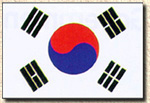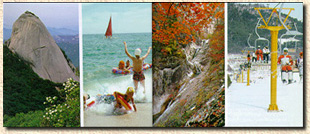
Location
East / 131' 51' 42" E Land The Korean Peninsula is 222,154 square Kilometers, almost the same size as the U.K or Romania.
The administrative area of South Korea is 99,392 square kilometers, slightly lagrer than Hungary or Portugal,
and a little smaller than Iceland.
The Korean capital city, Seoul, is one of the cities that have been labeled a "megacity" ,
with about twelve million people. This dynamic and thriving city is the center of the
Korean economy and culture.
Korea had a population of 44.5 million in 1994, and registered a density of 447 persons per square kilometer. Gross Nation Product The gross nation product of Korea was approximately $10,000 as of 1996.
National flag
Taegukki, the Korean national flag, has the taeguk circle in the center, and the four three bars at each corner.
The Taeguk circle, Yin and Yang, (an ancient symbol of the universe) represents the great cosmic forces that oppose
each other yet achieve perfect harmony and balance. The four three bars represent the ideas of opposition and balance.
The white background, shows the purity, harmony, and the peace-loving mind of the Korean people.
In 1882, Park Young-Hyo used the Taegukki for a first time and this was selected as the national flag in 1883.
The Mugunghwa, the Korean national flower, or rose of Sharon, means endless. This represent the permanent state of Korea. Rose of Sharon symbolizes perseverance because of its endurance and long life. This spirit reveals Koreans' national character. The Korean national anthem, Agukka, was written in Aug. 1948 at the same time of establishment of Republic of Korea. This is a solemn and terse song. Korean language
Koreans use both Hangal, the Korean language, and Hanja, Chines language.
The Korean language relates to the Ural-Altaic language group which also similar to Turkish. Once upon a time in Korea, there were various Korean tongues. but in the seventh century when The three kingdom one, they unified Korean tongue into one language.
Nowadays, Korean speak one Korean language and write the Korean alphabet, Hangul, whice was invented in 1443 by king Sejong the Great.
|
| Holidays | ||
| Jan 1st (New Year's day) | Jan 1st By the Lunar calendar (Sol) | Mar 1st (Independence Movement Day) |
| Apr 5th (Arbor Day) | Apr 8th By the Lunar calendar (Buddha's birthday) | May 5th (Children Day) |
| June 6th (Memorial Day) | July 17th (Constitutional Day) | Aug 15th (Liberation Day) |
| Aug 15th By the Lunar calendar (Choosuk or Harvest festival day) | Oct 3rd (National Foundation Day) | Dec 25th (Christmas) |
|
Climate Korea is situated on the east Asian monsoon belt. This means moderately cold and dry winters, with long periods of clear sky and hot humid summers. Comparatively, Spring and Autumn are rather short., but they boast beautiful weather and blue skies.
|











 The Korean national flag, the Taegukki is a symbol of peace, unification, creation, light
and eternity.
The Korean national flag, the Taegukki is a symbol of peace, unification, creation, light
and eternity.
 The Korean national flower, Mugunghwa, is beloved by every Koreans through its beauty and perseverance.
The Korean national flower, Mugunghwa, is beloved by every Koreans through its beauty and perseverance.
